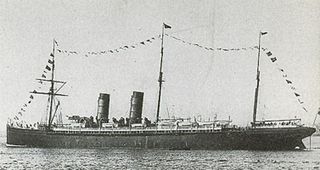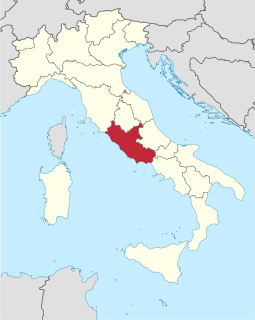
Lazio is one of the 20 administrative regions of Italy. Situated in the central peninsular section of the country, it has almost 5.9 million inhabitants – making it the second most populated region of Italy – and its GDP of more than 170 billion euros per annum means that it has the nation's second largest regional economy. The capital of Lazio is Rome, which is also Italy's capital and the country's largest city.
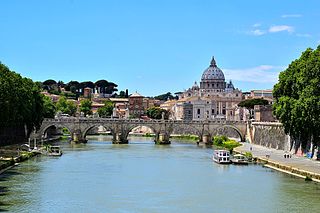
The Tiber is the third-longest river in Italy, rising in the Apennine Mountains in Emilia-Romagna and flowing 406 kilometres (252 mi) through Tuscany, Umbria and Lazio, where it is joined by the river Aniene, to the Tyrrhenian Sea, between Ostia and Fiumicino. It drains a basin estimated at 17,375 square kilometres (6,709 sq mi). The river has achieved lasting fame as the main watercourse of the city of Rome, founded on its eastern banks.

Umbria is a region of central Italy. It includes Lake Trasimeno and Marmore Falls, and is crossed by the River Tiber. The regional capital is Perugia. Umbria is known for its landscapes, traditions, history, culinary delights, artistic legacy, and influence on culture.
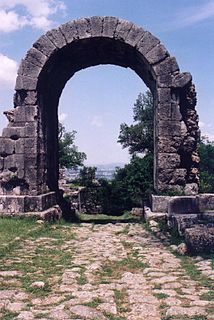
The Via Flaminia was an ancient Roman road leading from Rome over the Apennine Mountains to Ariminum (Rimini) on the coast of the Adriatic Sea, and due to the ruggedness of the mountains was the major option the Romans had for travel between Etruria, Latium, Campania, and the Po Valley. Today the same route, still called by the same name for much of its distance, is paralleled or overlaid by Strada Statale (SS) 3, also called Strada Regionale (SR) 3 in Lazio and Umbria, and Strada Provinciale (SP) 3 in Marche. It leaves Rome, goes up the Val Tevere and into the mountains at Castello delle Formiche, ascends to Gualdo Tadino, continuing over the divide at Scheggia Pass, 575 m (1,886 ft) to Cagli. From there it descends the eastern slope waterways between the Tuscan-Emilian Apennines and the Umbrian Apennines to Fano on the coast and goes north, parallel to Highway A1 to Rimini.

Marche, or the Marches, is one of the twenty regions of Italy. The name of the region derives from the plural name of marca, originally referring to the medieval March of Ancona and nearby marches of Camerino and Fermo. Marche is well known for its shoemaking tradition, with the finest and most luxurious Italian footwear being manufactured in this region.

Todi is a town and comune (municipality) of the province of Perugia in central Italy. It is perched on a tall two-crested hill overlooking the east bank of the river Tiber, commanding distant views in every direction.
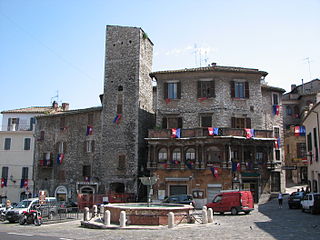
Narni is an ancient hilltown and comune of Umbria, in central Italy, with 19,252 inhabitants (2017). At an altitude of 240 m (787 ft), it overhangs a narrow gorge of the Nera River in the province of Terni. It is very close to the geographic center of Italy. There is a stone on the exact spot with a sign in multiple languages.

Norcia, traditionally known in English by its Latin name of Nursia, is a town and comune in the province of Perugia (Italy) in southeastern Umbria. Unlike many ancient towns, it is located in a wide plain abutting the Monti Sibillini, a subrange of the Apennines with some of its highest peaks, near the Sordo River, a small stream that eventually flows into the Nera. The town is popularly associated with the Valnerina.

The Province of Terni is the smaller of the two provinces in the Umbria region of Italy, comprising one-third of both the area and population of the region. Its capital is the city of Terni. The province came into being in 1927, when it was carved out of the original unitary province of Umbria.
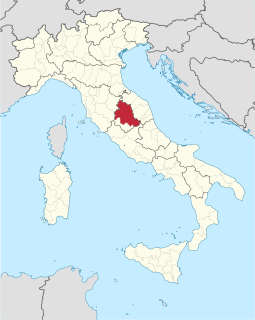
The Province of Perugia is the larger of the two provinces in the Umbria region of Italy, comprising two-thirds of both the area and population of the region. Its capital is the city of Perugia. The province covered all of Umbria until 1927, when the province of Terni was carved out of its southern third. The province of Perugia has an area of 6,334 km² covering two-thirds of Umbria, and a total population of about 660,000. There are 59 comunes in the province. The province has numerous tourist attractions, especially artistic and historical ones, and is home to the Lake Trasimeno, the largest lake of Central Italy. It historically the ancestral origin of the Umbri, while later it was a Roman province and then part of the Papal States until the late 19th century.

The province of Arezzo is the easternmost province in the Tuscany region of central Italy. Its capital is the city of Arezzo. The province is bordered by the regions of Marche, Emilia-Romagna, Umbria, and the provinces Siena and Florence of Tuscany. It has an area of 3,233 square kilometres (1,248 sq mi), a total population of about 344,000 in 36 comuni
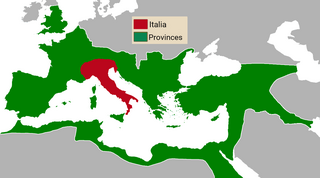
Italia was the homeland of the Romans and metropole of Rome's empire in classical antiquity. According to Roman mythology, Italy was the new home promised by Jupiter to Aeneas of Troy and his descendants, ancestors of the founders of Rome. Aside from the legendary accounts, Rome was an Italian city-state that changed its form of government from Kingdom to Republic and then grew within the context of a peninsula dominated by the Etruscans in the centre, the Greeks in the south, and the Celts in the North.

The Umbri were Italic peoples of ancient Italy. A region called Umbria still exists and is now occupied by Italian speakers. It is somewhat smaller than the ancient Umbria.

Sabina, also called the Sabine Hills, is a region in central Italy. It is named after Sabina, the territory of the ancient Sabines, which was once bordered by Latium to the south, Picenum to the east, ancient Umbria to the north and Etruria to the west. It was separated from Umbria by the River Nar, today's Nera, and from Etruria by the River Tiber. Today, Sabina is mainly northeast of Rome in the regions Lazio, Umbria and Abruzzo. Upper Sabina is in the province of Rieti. Sabina Romana is in the province of Rome. Part of Sabina is in the regions of Umbria and Abruzzo.

Pietralunga is a comune (municipality) in the Province of Perugia in the Italian region Umbria, located about 35 km (22 mi) north of Perugia. As of 31 December 2004, it had a population of 2,343 and an area of 140.2 km².

Umbria was a protected cruiser of the Italian Regia Marina built in the 1890s. She was the lead ship of the Regioni class, which included five other vessels. All of the ships were named for current or former regions of Italy. The ship was equipped with a main armament of four 15 cm (5.9 in) and six 12 cm (4.7 in) guns, and she could steam at a speed of 18 knots. Umbria spent much of her career abroad, including several years in American waters. In service during a period of relative peace, Umbria never saw combat. In 1911, she was sold to Haiti and renamed Consul Gostrück, though she did not serve for very long under the Haitian flag. Her crew was too inexperienced to operate the ship, and she foundered shortly after being transferred to the Haitian Navy.
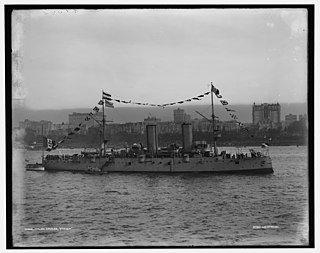
The Regioni class was a group of six protected cruisers built for the Italian Regia Marina in the late 1880s through the early 1900s. The class comprised Umbria, Lombardia, Etruria, Liguria, Elba, and Puglia, all of which were named for regions of Italy with the exception of Elba, which was named for the island. The class is sometimes referred as the Umbria class, for the first ship to be laid down. The ships, built by four different shipyards, varied slightly in their size, speed, and armament, but all could steam at about 18 kn and their main armament consisted of four 15-centimeter (5.9 in) guns and six 12 cm (4.7 in) guns.
The following is a timeline of the history of the city of Perugia in the Umbria region of Italy.

